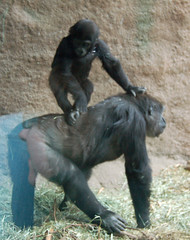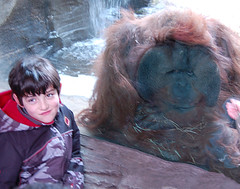Rafe and I visited the Woodland Park Zoo on January 2nd. We LOVE going to the zoo but rarely get to, so this was a big treat for us. What made it more exciting was that the animals hadn’t had many visitors in the past couple of weeks due to bad weather and holidays, so they were excited to see us too. Even on this freezing cold day any of the animals that had thick fur were out and about, lounging around on rocks or scrounging their habitats for food. We got to see animals that normally wouldn’t give zoo visitors so much as a glance: snow leopards, a wolf, wild dogs, even the gorillas seemed in a good mood. They viewed us from their side of the fence, totally comfortable with us staring back like the obsessed fans and paparazzi we truly are.
But the most exciting interaction that day was between Rafe and a siamang (a type of gibbon). They are tropical animals, and so were keeping warm inside their enclosure. They are typically friendly and interested in the humans that come by, and today was no exception.
As we walked up to peer inside their enclosure, the female siamang came over to look at us. Rafe, a large and fairly intimidating figure, got down to a crouching position in hopes the siamang would come over to see us. Instead, she hopped and shook at us. We weren’t sure if this was a threat behavior or not. The siamang shook and jumped again. This time Rafe tried it too. This frankly shocked the siamang, and so she did it a third time. When Rafe jumped a second time, she came straight over to the glass, as if to give Rafe a piece of her mind. She stared at him intently. Then, she turned her back towards him, almost as if a child does when pouting. She glanced over her shoulder at him. She reached out her right hand, one of her long fingers extended. Rafe pretended to grab it through the glass. She sort of wiggled her finger in response, and kept staring at Rafe. So Rafe tried something else. He started play-grooming her through the glass.
It looked very silly, this big man squatting down picking at the glass next to a siamang’s back. I expected the siamang to jump back from this weirdo (gently) tapping and scraping on her window. But instead, she seemed to relax into it. She put her arm down and turned away from Rafe so that she was no longer looking at him, but seemed interested in him continuing. He kept miming picking at her fur, even pretend ate a couple of mites he found.
This behavior went on for awhile. The siamang would look back occasionally to make sure Rafe was still going, especially if he paused for a minute, and so Rafe continued. The sight of a grown man grooming a siamang got the attention of a couple of other zoo goers, and they came over to watch. The siamang just stayed right there, being play-groomed.
Eventually Rafe stopped, and the siamang sort of looked up at him expectantly. Then she quickly jumped down from her side of the glass and swung off to explore other things.
Rafe and I giggled at this event and continued through the exhibit to see the other siamang. But the female wasn't done yet, and found us at another window. Once again Rafe crouched on all fours to say hello again. She came over to the glass, and reached out a hand for Rafe. She then turned her back to the glass, again as if she weren’t interested in him. Rafe began grooming her. She looked over her shoulder at Rafe, and seemed content to continue this activity. Just to see what would happen, Rafe stopped and moved over to another part of the glass. The siamang followed, and repositioned herself against the glass. Rafe continued grooming.
This was an incredibly odd sight to see a human primate being allowed, nay, encouraged, to groom a siamang, even if it was through the safety of thick glass. It seems unlikely that she could have felt him as he gently tapped his two fingers against the glass as he grabbed at imaginary mites.
Again a crowd formed, and eventually one of them said he should turn around and present his back to the siamang to be groomed. He did. For a second, they just sat there, back to back. Then, she turned around and actually started to groom Rafe. A pick here, a pick there, through the glass she grabbed at invisible mites. After about 20 seconds though, she turned around and pressed herself back up against the glass, and it was once again Rafe’s turn. We all laughed, someone said she was being selfish, and Rafe went right back to grooming her.
Eventually the crowd dispersed, and it was time to move away from the siamang enclosure. Rafe stopped grooming her and sat back on his haunches. She was not looking at him but realized he had stopped grooming her, and turned to look at him. Rafe put his hand up against the glass to say good bye, and if I remember correctly she tapped at it, but almost as if to request more grooming. Rafe instead stood up and walked to the other side of the glass. The siamang followed him there, and when she realized their grooming session was over, hopped over to a branch in her enclosure and then ran off to find other exciting things.
As we walked away we couldn’t help but laugh in awe and amazement at this interaction. First, who thinks to play-groom with a wild animal, especially through practically bullet-proof glass? Apparently Rafe does. And the fact that the siamang took to it was just amazing, and almost unreal to see. Let alone that the siamang actually groomed Rafe back, albeit for only a short, half-hearted time. The inter-species interaction was completely surreal.
Did anyone else happen to be at the zoo that day and see this? What was your reaction? Have you ever seen this type of behavior before, not even from siamangs specifically, just other primates in general? After this event I almost wonder if this is something the siamang has tricked other visitors into doing, but again, who thinks to play-groom?







